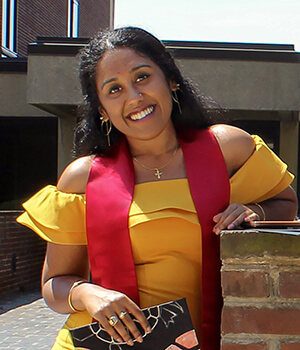- July 31, 2019
- By Sala Levin ’10
Fear, anxiety, shame—victims of human trafficking struggle with myriad psychological issues as they try to recover from their trauma. Shelters can provide a haven for these girls and women, but after visiting several during alternative breaks as a UMD undergraduate, Lonna Babu ’16 M.Arch. ’18 wondered: Can shelters be built specifically to address the needs of survivors transitioning into a healthy life?
Yes, she thought. So she designed one.
Now, Babu’s master’s thesis project, “Safe Space: Architectural Sequence as a Healing Experience,” has been chosen for inclusion in the American Institute of Architects’ 2019 Emerging Professionals Exhibit; the theme of this year’s digital showcase is “Designing for Equity.”
“I saw the relationship architecture could have to these girls,” she said.
The design for the 30-unit residential and learning facility revolves around a central garden courtyard, open to the sky, where survivors can plant fruits and vegetables and gain the skills to cook meals from scratch, developing self-sufficiency.
“The courtyard is a very powerful way to bring people together,” said Peter Noonan, professor of the practice, who was Babu’s thesis adviser. “[Babu] investigated how courtyards were used throughout history in different cultures, and then used that research to be a vehicle for this transitional place of housing for the clients that would be working their way back into some kind of a healing and reintegration into society.”
The shelter also has classroom space where residents could take classes in academic subjects as well as practical ones, such as self-defense, resume-writing and career skills.
“One of the biggest things was giving girls a lot of opportunities to make their own choices—that’s something that’s stripped away from them when they’re forced to do whatever their trafficker tells them,” Babu said.
Transitional features such as windows and doorways were also key to Babu’s design, allowing the space to be safe and secure but open at the same time. “The wall between the courtyard and the dorm rooms or the classrooms … let there be a seamless transition between these healing gardens and the communal spaces,” Noonan said.
Babu researched potential sites along the East Coast, ultimately settling on Baltimore’s Greenmount West neighborhood, a transitioning area in the city’s arts and entertainment district. “The neighborhood is scattered with murals that speak to this growth, community spaces, community parks and makerspaces. The idea that these survivors could become a part of this change and grow with the community … was a powerful idea in order to de-stigmatize these young girls and women,” Babu said.
Now an architect at the Baltimore firm Design Collective, Babu hopes her project will show how design and architecture can play a role in real-world social justice initiatives. “Even if you’re not building a full-on shelter, there are a lot of different aspects you can take into existing shelters,” she said. “It can start small and hopefully one day become a real, big thing.”
